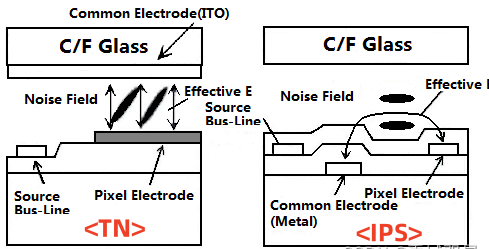When we use an LCD monitor, if we find that when the screen switches, the previous screen does not disappear immediately, but disappears slowly, we call this phenomenon the "image retention" phenomenon of the LCD monitor. To put it simply, the first screen should disappear and the second screen should appear, but the first screen always does not disappear, affecting the visual effect and the appearance of the second screen, causing abnormal display. Under normal circumstances, the service life of an LCD monitor is about four or five years, and the image retention phenomenon will not occur normally.
How does afterimage occur?
principle
TFT-LCD is also called thin film transistor LCD, including VA, IPS, FFS, TN and other subtypes. Image sticking is one of its most common undesirable phenomena, among which the image sticking problem of IPS and FFS is the most prominent. Since the internal pixel electrodes and common electrodes of IPS are distributed laterally, the electric field is unevenly distributed in the surface, which is easy to produce DC bias. In addition, the CF film does not have an indium tin oxide shielding layer like TN. The ionic impurities in the organic layer easily enter the ITO film of the liquid crystal layer, causing residual charges to interfere with the electric field, so it is relatively easy to have image sticking.

The mechanism of image sticking is somewhat complicated. It usually occurs when the same image is displayed for too long. The charged ions in the liquid crystal are adsorbed on the upper and lower glass ends to form a built-in electric field. After the image switches, these ions are not released immediately, causing the liquid crystal molecules to fail to immediately rotate to the required angle.
Another possible situation is that the pixel electrode design is poor, causing the liquid crystal molecules to be arranged in disorder when switching states, in which case it is also possible to see afterimages. So it is wrong to think that if the response time is fast, there will be no afterimages.
Afterimage and response time are not the same thing. Afterimage may take two or three seconds to completely disappear, while the response time of LCD is ten to several tens of milliseconds. A well-designed LCD monitor will not allow users to see afterimage even if the response time is 15+35ms.
How to test image sticking:
The panel manufacturer's method of testing image sticking is to watch the black and white checkered screen of a chessboard at room temperature for twelve hours, and then switch to 128 grayscale. The standard is that the image sticking must disappear within 5 seconds. When users buy a monitor, they can use a power poin to draw some pictures of black squares with a white background and a 128 grayscale picture to switch. If it is troublesome, you can also set the screen background to 128 grayscale, and then call out the mines to explode (all black mines will be displayed), leave it for tens of seconds or minutes and then turn it off. One thing to note is, don't stare at the test screen all the time, switch it and then look at it, otherwise you may see the visual residue of the human eye.
How to solve the "afterimage" problem of LCD Display?
Screen saver: When the system is not running, let the pixels of the TFT display different content, that is, display a moving screen saver or switch the content at irregular intervals, avoid displaying static pictures for more than 20 minutes, clear the screen, and let the TFT fill all black or white when the system is not running; turn off the backlight to further extend the life of the backlight LED:
Turn off the power and let the TFT screen sleep when not in use to avoid any unnecessary driving;
Signal, the display scanning signal should be provided continuously after power-on to avoid scanning pause causing TFT drive; power timing, pay attention to the power on and off timing sequence.
TFT LCD screen image sticking test standard
Test (example):
Normal temperature; black and white checkerboard display (each grid is about 60x60 pixels); static display for 30 minutes.
Judgment (example):
Full screen display 128 (50%) gray: After waiting for 10 seconds, no residual image can be considered qualified.
For more relevant knowledge, please contact us directly!







 Search
Search





